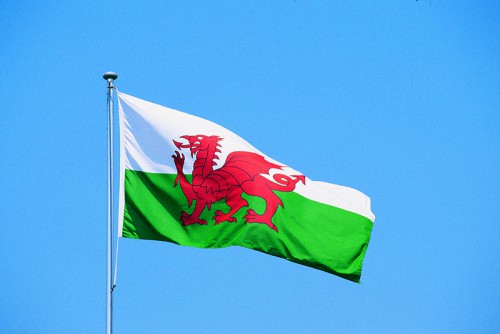1st March 2015
Dragons and daffodils…..
Today is 1 March and the Welsh flag, Y Ddraig Goch, was flying outside the British Embassy as we mark St David’s Day. And several of us are wearing dragon or daffodil badges in our lapels or as cufflinks to recognise the patron saint of Wales. The date marks the anniversary of the death of St David (or “Dewi Sant”), possibly in 588 or 589 AD. He was a Celtic monk, abbot and bishop, perhaps of royal descent. During his life, he was archbishop of Wales, and he was one of many early saints who helped to spread Christianity among the pagan Celtic tribes of western Britain. He was in fact the only Patron Saint of the four chief nations of the United Kingdom to have been born in the land that adopted him.
Many traditions and legends are associated with St David. When he rose to address to a great crowd at one famous synod, when he could not be heard, he laid a handkerchief on the ground and stood on it to speak, whereupon it is said that the ground rose under his feet forming a little hill so that all could hear him speak and a golden-beaked dove is said to have landed on his shoulder as a symbol of his holiness. As he prepared for his death, St David uttered his most famous words. “Lords, brothers and sisters, be cheerful, keep the faith, and do those little things which you have seen me do and heard me say.” Another popular legend tells us that St. David advised the Britons on the eve of a battle with the Saxons to wear leeks in their caps so as to easily distinguish friend from foe. This helped to secure a great victory for the Welsh. (The words for “daffodil” and for “leek” – both national emblems of Wales – are virtually the same in Welsh.) And this may be why both have been adopted as national emblems and are key features of the 1 March celebrations. In Wales itself, the 1 March celebrations involve singing, poetry and traditional food. I’m not sure what the aesthetic St David, who lived mostly on bread and water, would have made of this.
There are some important health links between Wales and Ethiopia – between Glan Clwyd, Rhyl and Hossana; between Wrexham and Yirga Alem/Hawassa; and between Abergawenny and Hawassa (through midwives@ethiopia). And there are a number of other bilateral associations – charitable, religious, artistic, cultural and commercial (a number of the wings of aircraft in Ethiopian Airlines’ future fleet will have been made in Wales). As a half-Welshman, I invite our Ethiopian friends to celebrate these partnerships with us today. If you want to be truly engaged, you can even support the Welsh rugby team as they battle through the Six Nations and then, later this year, the Rugby World Cup. In the meantime, you can find a message from the First Minister of Wales on the occasion of St David’s Day at http://www.wales.com/en/content/cms/english/st_davids_day/stdavidsdaymessage/.
Diolch!

Greta to see this Greg ! Hope all is well with you ? and the family